

| Sallow Moth identification |
| ...... |
| Those not familiar with
our native moths, are often surprised by the range of
colours and attractive markings shown by many species. Some of our most colourful moths are the Sallows (most formerly Xanthia) but following a recent overhaul of the UK species by Agassiz, Beavan and Heckford in 2013, only Pink-barred Sallow remains unchanged. Most of the Sallow moths are common in Nottinghamshire and with much the same range as each other. All seem to be more common in woodlands north-east of Mansfield, but their range forms a broad band running south-west to north-east through the county. In reality, these moths are probably much more widespread in the county, which may be down to recorder coverage later in the year, when these moths fly. The four most similar and sometimes problematic moths detailed here (Barred Sallow, Pink-barred Sallow, Sallow and Centre-barred Sallow) are all Autumn fliers. |
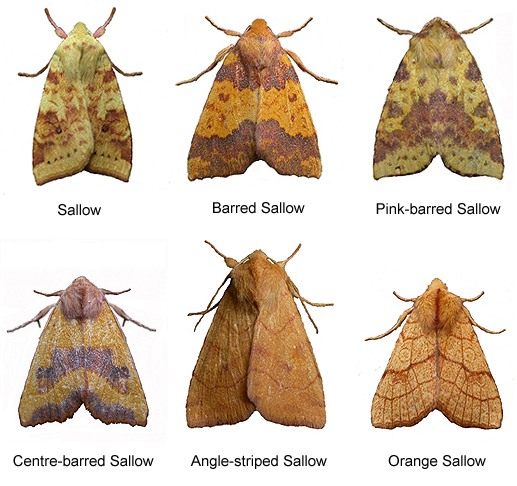 |
|
| ...... | ||
| Similar
species Shown with these, are two other Sallows (Angle-striped Sallow and Orange Sallow) both of which should not really present any identification problems, to anyone new to moths and moth trapping and are only included in the above illustration, purely becuse they fly at the same time and have 'Sallow' in their common name. Both these moths show cross-lines, some degree of rounded oval and kidney-mark and have a more light brown/orange ground-colour on the forewing. The forewing ground-colour of all the other Sallows is distinctly yellow. Orange Sallow is not common in Nottinghamshire and is a moth we have only recorded once personally (at Eakring in 2010) in over ten years of regular trapping. Angle-striped Sallow has much the same distribution as the other Sallows, but shows a slightly more westerly-bias to its range, although it has turned up at sites in the far east of Nottinghamshire. |
||
| 73.180 .... B&F 2272 .... Barred Sallow Tiliacea aurago ([Denis & Schiffermüller], 1775) .... Formerly known as Xanthia
aurago |
Nottinghamshire status and distribution: Regularly recorded from several deciduous woodland sites in the northern-half of Nottinghamshire. Barred Sallow is by no means restricted to woodland and is also found in a variety of rural habitats such as farmland and occasionally gardens. Flight period: Flies from September to October. The records we have, show it to be equally as common in both months. Identification features: Forewing colour is usually a rich golden yellow, with two dark redish/purple bands running across the forewing. Of the four species, Barred Sallow has the more contrasting and distinctive markings, usually showing little variation. |
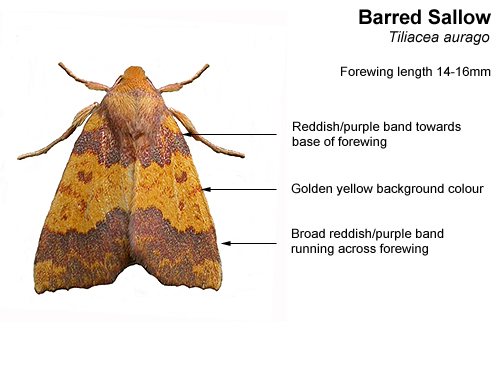 |
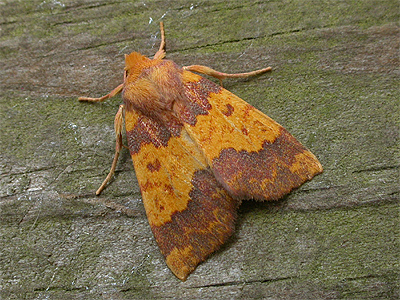 |
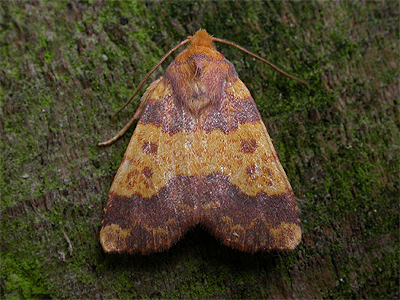 |
|
| 73.181 .... B&F 2273 .... Pink-barred Sallow Xanthia togata (Esper, 1788) |
Nottinghamshire status and distribution: Virtually the same Nottinghamshire distribution as the previous species and is commoner in the north of the county. There are records from the south-west of Nottinghamshire, where this moth may suffer from being under-recorded. Flight period: Flies from September to October, with most records occurring in September. Identification features: Pink-barred Sallow is one of our most attractive moths. The forewing colour is yellow, which will be less bright on older individuals. On extremely fresh moths (see photograph below) the forewing back-ground colour can be a rich golden yellow, with contrasting dark pink markings, that become more dull with age. |
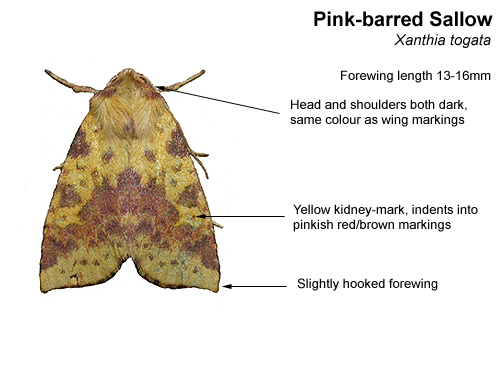 |
|
| The amount of
spots and blotches on the broad (slightly hooked)
forewings varies, but there are usually two fairly large
triangular blotches situated about a third and two thirds
of the way along the leading edge of the forewing. The
indistinct yellow kidney-mark, indents into a series of
dark pink (often reddish-brown) scalloped markings, which
form a bar across the forewing. The kidney mark is
darkened at one end, which is often the darkest of all
the forewing markings. The most distiguishing identification features are the dark head and shoulders, not present on any of the other Sallows. |
||
| ...... | ||
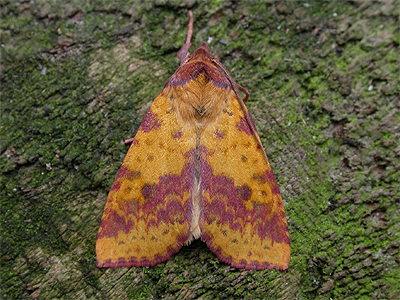 |
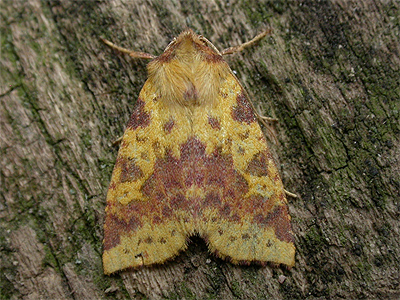 |
|
| 73.182 .... B&F 2274 .... Sallow Cirrhia
icteritia (Hufnagel, 1766) .... Formerly known as Xanthia
icteritia |
Nottinghamshire status and distribution: Common, with a Nottinghamshire range extending from the south-west to the very north-east of the county. Fairly regular to MV light at Sherwood Forest sites and the Idle Valley NR. Not restricted to woodland and is found in a wide variety of habitats, including gardens. Flight period: Flies from August through to October, with a pronounced peak in September. Identification features: More narrow-winged than the other Sallows, which are slightly hook-tipped. Forewings have a lemon yellow ground-colour, with markings which vary (see accompanying photographs) in intensity. Pale, or less well-marked individuals, will show a distinctive dark spot, which forms part of the kidney-mark. This will still be a prominent feature on more well-marked specimens, but slightly more lost within the reddish/brown forewing markings. |
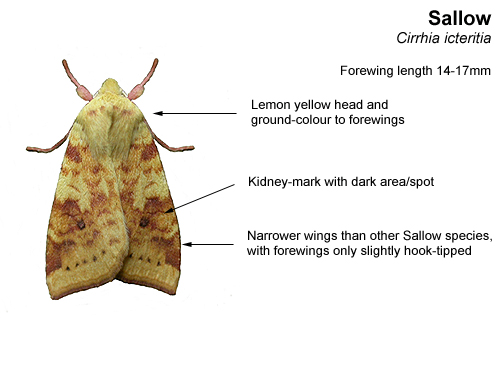 |
|
| The reddish/brown wings markings create a more marbled effect, but three blotches are a usual feature on most moths, found at regular intervals along the leading-edge of the forewing. The oval and kidney-mark are never obvious and are often hard to detect. | ||
| ...... | ||
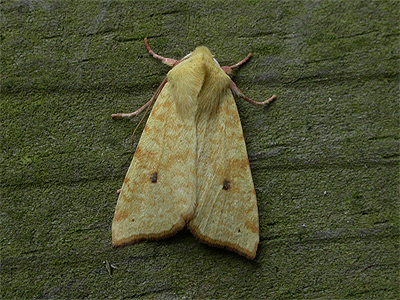 |
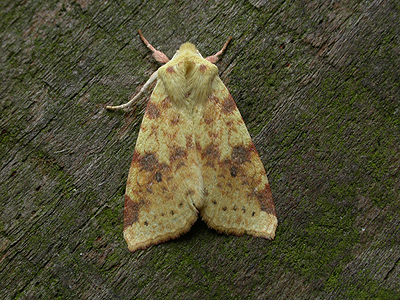 |
|
| 73.219 .... B&F 2269 .... Centre-barred Sallow Atethmia centrago (Haworth, 1809) |
Nottinghamshire status and distribution: Most common in the north of Nottinghamshire and is often common where it occurs. Dound in deciduous woodland containing Ash, but also in more open sites, agricultural countryside and is occasionally recorded from suburban gardens. Flight period: Flies in August and September, with an obvious peak in September. Identification features: This is a distinctive moth, with dark yellow forewings and two distinctive pinkish red/brown bars that do not reach the leading-edge of the forewing. Worn individuals can appear 'scruffy', but the central wing bar is always an obvious feature. The wing bar is partially indented into by the completely dark kidney mark and is contained within a faint, straight cross-line in the centre of the forewing and a strongly curved cross-line running through the outer half. |
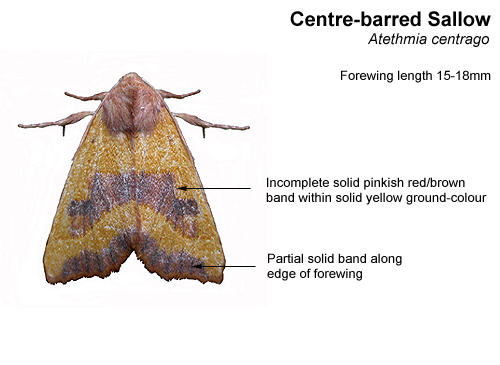 |
|
| The head and thorax are both completely dark, reddish brown, but very different in appearance to tthat of Pink-barred Sallow. | ||
| ...... | ||
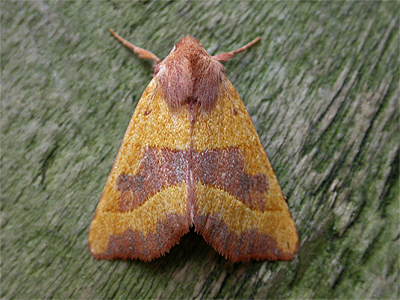 |
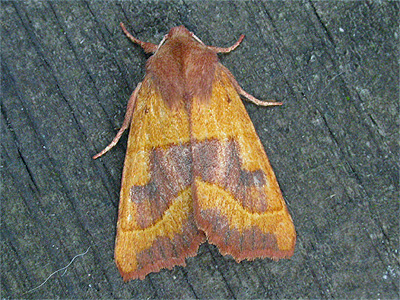 |